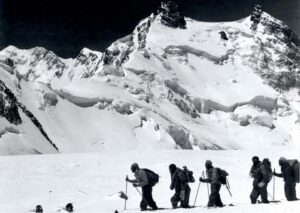Almost 7,000m below the Philippine Sea, explorers found a record-breaking relic from the past.
USS Destroyer Escort Samuel B. Roberts sank there after a WWII battle, never to be seen again until former naval commander Victor Vescovo and his team of explorers found it on June 22. Vescovo’s outfit, Caladan Oceanic Expeditions, located the wreck with help from EYOS Expeditions.

EYOS Expeditions’ Kelvin Murray and Victor Vescovo. Photo: EYOS Expeditions
Broken into two pieces, the affectionately-named “Sammy B” rests on the ocean floor at a record 6,985m. According to the Associated Press, that makes it far and away the world’s deepest discovered shipwreck.
The previous record-holder, the USS Johnston, also sank in the Pacific in WWII. Another EYOS Expeditions team found it in 2019, resting at a depth some 426m shallower than the Sammy B.
“It was an extraordinary honor to locate this incredibly famous ship, and by doing so have the chance to retell her story of heroism and duty to those who may not know of the ship and her crew’s sacrifice,” Vescovo said in a statement.
The Battle of Samar
The ship’s story came to a climax at the Battle of Samar in 1944. The battle revolved around a “small US naval force” successfully defending a position against Japanese forces despite being outgunned. The Japanese flotilla included six heavy cruisers, two light cruisers, eleven destroyers, and four battleships including the Yamato, “the most heavily armed battleship ever constructed,” per EYOS Expeditions. The AP said the Sammy B disabled a Japanese heavy cruiser with a torpedo and significantly damaged another while battling the group.
However, reports indicate the battleship Kongo finally sank the destroyer escort after it spent virtually all its ammunition.
Of the Sammy B’s 224-member crew, 89 died in the incident, per the AP. BBC News’s Jonathan Amos reported the 120 rescued crew members survived by clinging to wreckage in the water for up to 50 hours after the battle.
Well-preserved remnants tell violent story
Vescovo noted that a scant debris trail made finding the momentous wreck a surprise. The team was searching for several vessels, of which the Sammy B was the smallest. When they did find it, Vescovo said, the ship was relatively intact despite being broken in two. Still, it bore glaring battle scars.
“The Sammy B bore evidence of the incredible, ferocious fight that she waged against the cream of the Imperial Japanese Navy,” Vescovo told Amos. “There were shell holes. She obviously had taken a massive hit from a battleship on her stern quarter, with it basically blown apart.”
The extreme depth of the vessel’s final resting location also served to limit the biodegradation shallower wrecks often exhibit.
“At that depth, there’s so little oxygen that you don’t get nearly as much biological growth on the wrecks,” Vescovo told the BBC. “So they can appear very much like they did when they were fighting back in 1944.”






